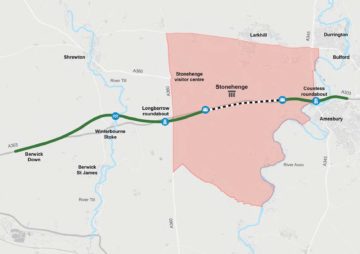All infrastructure investing involves balancing costs with benefits, some of which are hugely subjective – is an hour saved by not sitting in a traffic jam worth an hour at work or an hour at leisure? Why are these often valued differently? Does the fact that the UK has built more infrastructure in the south east of England mean that people’s time there is more valuable than northerners’? And now we need to price a view.
Not any old view, mind you, but that from the UK’s oldest piece of infrastructure, Stonehenge (project life: 5,000 years and counting) which is blighted by the seasonal traffic jam otherwise known as the A303 road which had, for reasons buried in much more recent history, been built a mere 165 meters from the sarsens and bluestones and thus encroaches somewhat on their tranquility and, yes, dignity.
So build a tunnel (A bypass around a nearby village and some junctions are included too). Highways England maintains that the scheme will cut congestion and improve journey times but let’s not pretend that improving the ambience of Stonehenge is not part of the justification for spending GBP1.6 – 1.7 billion and perhaps more. I would be prepared to pay an awful lot to improve that view but how much is that? There are perhaps four options. All require a view, as it were, to be taken on the value to be ascribed to the view.
You could channel Steve Waugh, Mario Draghi and Rishi Sunak and do Whatever It Takes. After all, the cost was no doubt eye watering when it was originally built. This project was included in the government’s GBP 27 billion infrastructure plan post Brexit (remember those sunny uplands?) and a shortlist of three consortia was announced last month. But the government is already taking the WIT approach on HS2 (GBP 300 million per mile) and Hinckley Point C (GBP 7 million per MW). As the colourful US senator Everett Dirksen once told Johnny Carson, “a billion here, a billion there and pretty soon you’re talking real money”.
You could bring down the cost by revisiting the design. However, this has already led to controversy over, for example, the tunnel portals being within the World Heritage Site, i.e. not far enough away. UNESCO wants the tunnels to be longer. The also colourful Chairman of Amesbury Museum and Heritage Trust, Andy Rhind-Tutt, described the shorter tunnel plan as a “self-destructing time bomb” which would “do nothing” for traffic problems in the area.
You could look to share the risk with the private sector. However, having pioneered Project Finance / Public Private Partnerships / the Private Finance Initiative (Devon silver mines were financed on a limited recourse basis in 1299 when Edward I was King), more recent UK policy on the matter has flapped around like a landed fish and private sector appetite for anything other than building this project can be safely discounted.
Or you could forget the whole idea and file it in the Too Hard basket (or electronic equivalent). There is speculation that the scheme will indeed be scrapped which would be a shame.
As Minister, Grant Shapps had until 2 April to make the final decision but there has been no news since. Most likely, a mere thirty years into the debate on this project and in the age of Covid, he we will kick the can further down the (temporarily traffic – free) road – so the challenge of valuing the view will be still there as and when he returns to it.
Update July 2024: the incoming Labour govt includes this project in its Bring Out Your Dead review and finally cans it. It turns out that a view is not worth much after all.








